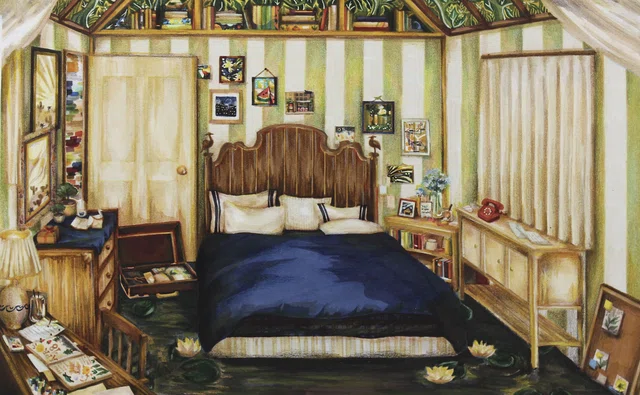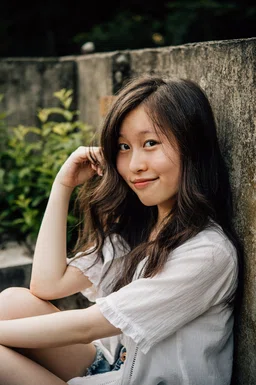




Stephanie Huang
Huang
WESTWOOD HIGH SCHOOL|Westwood, MA
TEACHER: Lucy Harackiewicz
Drawing

Swamp Sanctuary|7 x 11 in.
Idea: An imagined residence for a recluse stuck at home, objects hint at a desire for adventure and escape
Material(s): Alcohol marker, colored pencil, acrylic paint pen
Process(es): Layered muted tones over a bright alcohol marker base to create a swampy, bogged-down look.

This particular work, “Swamp Sanctuary,” represents both the loneliness and comfort of a solitary life.
Student statement
Student
statement

Stephanie Huang
Throughout my investigation, the question that guided my creative process was: “How can a space and the details within express abstract ideas?” I explored how concepts such as freedom, joy, and even the changing seasons could be reflected through the structures, objects, and colors in a space. Over the school year, I shifted from sketching my favorite outdoor spaces in real life to illustrating interior spaces from my own imagination.
This particular work, “Swamp Sanctuary,” represents both the loneliness and comfort of a solitary life.
The wall art depicting faraway places, the packed suitcase floating in the water, and the nature imagery represent one’s inner desire for escape, adventure, and reconnection to the outside world. The jumble of colors outside the doorway are a palette of all the markers used in the drawing. As the only abstract part of the piece, they reflect that when someone has been living a reticent, reclusive lifestyle for so long, returning outside can feel daunting or unpredictable - but ultimately, there is an abundance of possibilities waiting beyond the doorway when you are brave enough to take that step.
Untitled|7.25 x 8.25 in
Material(s): Technical ink pen on notebook paper salvaged from schoolwork
Process(es): Used delicate strokes to convey a wide range of values and materials in my favorite open spaces.
Teacher
statement
Lucy Harackiewicz
Stephanie Huang created a portfolio of stunning drawings filled with embedded layers of symbols and exquisite tiny details. Her idealized worlds signal to the viewer that there is much below the surface that will reward the careful observer.
Stephanie entered AP with extraordinary drawing ability, but verbalizing her thoughts, processes, and meanings behind her work was a more difficult skill to develop. Prior to the school year, she set up a Google site to house all of the summer written work, artworks in progress, research, meeting notes, ideas for future work, etc. This written repository of her thinking, along with the feedback she received, and notes from critiques kept everything together and became the place to refer back to frequently. The Google site was one important piece of scaffolding built into the course.
This archive of her thought processes became a resource for when she began to draft the writing portions of the exam. Her journaling contained things like a list she made of one hundred interesting things, her philosophy of art, and discovery notes of new artists and why she was drawn to them. Referring back to her journaling and her works in progress helped organize the overall portfolio-building as well as how to write about the work.
Weekly student-centered conversations also scaffolded the writing. The goals of these were to practice articulating what the work was about, to ask for feedback, and in turn to ask questions of each other. Stephanie kept notes to hold onto fleeting conversations and ideas before they disappeared and these notes became the building blocks to writing coherently.
For Stephanie, answering such questions did not come naturally at first, as her work came organically to her, without verbal intellectualization. The practice of looking at her output and stating their meanings honored the deep visual work she was making. As a result, she realized the work was more than her exquisite handling of materials with layer upon layer of amazing detail. Her idealized interiors can be seen as a psychological metaphor, a longing to travel, loneliness, feelings of comfortable coziness, and the fear of leaving that world. The viewer can virtually feel themselves in these works of her imagination because of the sincerity and fullness of her hand. Putting all of this into words made her understand more fully the breadth of what she accomplished.
Stephanie Huang





